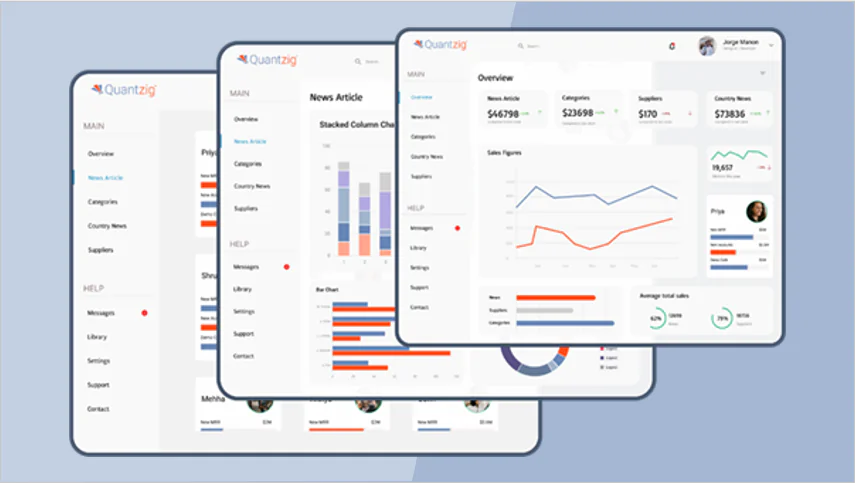In the dynamic landscape of 2025, the significance of marketing automation and artificial intelligence (AI) in delivering game-changing results for global marketing brands is on the rise. Now is the best time for e-commerce professionals and marketers to embrace these innovative technologies in their marketing strategies.
By leveraging sophisticated algorithms and cutting-edge technologies, marketing service providers empower organizations to uncover hidden patterns, decipher complex data sets, increase market size, and make informed decisions that resonate with ever-changing market demands. As businesses continue to navigate an increasingly data-centric environment, marketing analytics solutions have emerged as a critical tool for turning raw data into actionable insights. In this article, we’ll shed light on why, in 2025, all small and medium-sized industries should not merely consider but confidently choose a provider of marketing analytics solutions to gain a decisive edge in the competitive market and unlock the full potential of data-driven marketing strategies.
Don’t just keep up; lead the charge in 2025 – choose a marketing service solutions provider and elevate your organization to the forefront of industry innovation!
Book a demo to experience the meaningful insights we derive from data through our analytical tools and platform capabilities. Schedule a demo today!
Request a Free DemoTable of Contents
Read to know: Success Story of our marketing analytics services for our renowned US client:
| Client Details | A leading Retail Industry located in New York, USA with an annual revenue $100 million. |
| Challenges Faced by The Client | Client was facing multiple challenges around a lack of Data-driven Insights, Inefficient Marketing Campaigns, Limited Customer Understanding, and Intense Market Competition. |
| Solutions Offered by Quantzig | Quantzig helped the client with the implementation of Advanced Data Analytics, Customer Segmentation, Predictive Analytics, and Competitive Intelligence. |
| Impact Delivered | 20% Increase in Conversion Rates ,15% Reduction in Marketing Costs, Enhanced Customer Satisfaction, and Competitive Advantage. |
Client Details:
A leading Retail Industry located in New York, USA
Annual Revenue: $100 million
Challenges Faced by the client:
1. Lack of Data-driven Insights: The company struggled with making informed marketing decisions due to a lack of comprehensive data analysis and insights.
2. Inefficient Marketing Campaigns: The client faced challenges in optimizing their marketing campaigns, resulting in suboptimal customer targeting and low conversion rates.
3. Limited Customer Understanding: They lacked a deep understanding of their customer base, hindering their ability to tailor marketing strategies to specific customer segments.
4. Intense Market Competition: The client operated in a highly competitive market, necessitating the need for advanced analytics solutions to gain a competitive edge.
Solutions Offered by Quantzig:
Quantzig, a leading marketing analytics solutions provider, collaborated with the retailer to address their challenges and drive business growth. The following solutions were implemented:
1. Advanced Data Analytics: Quantzig leveraged cutting-edge data analytics techniques to collect, analyze, and interpret vast amounts of customer data. This enabled the company to gain valuable insights into customer behavior, preferences, and purchase patterns.
2. Customer Segmentation: By employing sophisticated segmentation models, our data analytics experts helped the retailer identify distinct customer segments based on demographics, buying behavior, and preferences. This allowed the client to tailor marketing campaigns and offers to specific customer groups, resulting in improved customer engagement and conversion rates.
3. Predictive Analytics: Quantzig developed predictive models to forecast customer demand and identify potential market trends. This empowered them to make data-driven decisions regarding inventory management, pricing strategies, and product assortment, leading to increased sales and profitability.
4. Competitive Intelligence: Our data analytics service providers conducted comprehensive competitor analysis to identify market trends, benchmark performance, and uncover untapped opportunities. This enabled the retailer to stay ahead of the competition and develop effective marketing strategies to differentiate themselves in the market.
Results and Benefits:
Through the implementation of Quantzig’s marketing analytics solutions, the client achieved remarkable results:
1. 20% Increase in Conversion Rates
2. 15% Reduction in Marketing Costs
3. Enhanced Customer Satisfaction
4. Competitive Advantage

What is Marketing Analytics?
Marketing analytics is the process of utilizing analytics tools and marketing data to measure and analyze various aspects of marketing performance, such as return on investment, consumer insights, and advertising effectiveness evaluation. It involves leveraging real-time analytics to inform marketing objectives and optimize the marketing mix through marketing mix optimization and marketing measurement and optimization platform. By staying abreast of MarTech trends and adhering to analytics best practices, organizations can effectively track marketing evolution, develop comprehensive marketing plans, and utilize statistics for marketing to enhance performance marketing strategies, ultimately driving success in social media marketing and beyond.
Marketing analytics involves the comprehensive analysis of various data points and metrics across multiple channels and touchpoints in the modern marketing landscape to understand customer trends and preferences, assess competition, and predict future results. Through techniques such as Media Mix Models (MMM), Multi-Touch Attribution (MTA), Marketing Mix Modeling, Social Media Marketing, Advertising Effectiveness Evaluation, and Unified Marketing Measurement (UMM), businesses can leverage data analysis to evaluate the effectiveness of their marketing campaigns and make informed decisions.
With a focus on data quantity and quality, supported by data scientists and advanced attribution models, organizations gain granular, person-level data and contextualized customer and market insights to enhance product intelligence, optimize customer support, and refine messaging and media strategies. This facilitates the development of product development trends and annual media plan recommendations while strengthening brand measurement capabilities and providing valuable insights to marketing analytics managers and stakeholders for continuous improvement and benchmarking.
What exactly does marketing analytics do to your organization?
Marketing data analytics is instrumental in offering businesses a comprehensive understanding of their overall landscape. It enables a detailed exploration of micro-level, specific trends within their industries. By leveraging this marketing data, businesses can enhance both the quality and quantity of leads, gaining valuable insights on effectively targeting the most desirable clients and optimizing advertising strategies. Ultimately, these advancements contribute to improving the organization’s financial performance.
Marketing analytical solutions are tools and techniques used to analyze marketing data and extract meaningful insights. These solutions help businesses measure the effectiveness of their marketing campaigns and make data-driven decisions. They provide valuable information about customer behaviors, demographics, and preferences. Marketing service solutions can track and analyze various metrics such as website traffic, conversion rates, and customer engagement. By utilizing these solutions, businesses can optimize their marketing strategies, improve customer targeting, and increase ROI.
By scrutinizing customer purchase patterns and preferences, this powerful tool allows your business to craft hyper-targeted marketing campaigns that accurately resonate with your target audience, fostering unwavering brand loyalty and delivering a competitive edge.
In a world where every advertising dollar counts, this level of targeting ensures maximum ROI, setting your organization apart from competitors. You’ll also get a real-time feedback mechanism and immediate insights into your campaign performance with this tool. By analyzing the performance of past campaigns, identifying what worked and what didn’t, and iteratively optimizing your strategies, you ensure a perpetual cycle of refinement. This commitment to excellence positions your organization as a dynamic force, always evolving and adapting to stay a step ahead in the competitive race.
How can your business benefit from the recent marketing analytics trends and innovations?

In today’s rapidly evolving business landscape, leveraging recent marketing analytics trends and innovations is paramount for driving success and staying competitive. By harnessing tools like Mailchimp and web analytics alongside advanced techniques such as predictive modeling and machine learning, businesses can enhance conversion rates, boost leads, and improve brand recognition.
Understanding user behavior and optimizing user experience (UX) through automation features and a seamless customer journey facilitates targeted digital marketing efforts, including PPC advertising, Social Media Marketing, Marketing Mix Modeling, Advertising Effectiveness Evaluation, Facebook ads, and email campaigns, resulting in improved ROI and increased customer engagement. Additionally, having a proficient enterprise-wide analytics team and a skilled marketing analytics manager ensures the effective utilization of predictive analytics and segmentation, enabling businesses to capitalize on emerging trends and drive sustainable growth. Here’s how this tool is helping every business:
1. Boost creativity sessions using AI:
With the integration of Generative AI tools, brainstorming sessions can be made more productive because these marketing tools quickly sift through data to uncover insights and trends that spark creative thinking within your team members. As a result, overcoming writer’s block and fostering discussions that yield creative ideas become more achievable. Ensure the consistency of your prompts and put your selected tool to the test by challenging it to produce more creative ideas than before.
2. Embrace Personalized Messaging for Impact:
Now, you can elevate your customer engagement strategies by adopting moments-based messaging, a personalized approach leveraging AI technology to identify and capitalize on real-time micro-moments within the customer journey. Harnessing this method ensures that your marketing campaigns consistently resonate with the desires and demands of your customers, fostering brand loyalty and increased conversions.
3. Optimize segmentation with AI:
An effective way to optimize your business marketing strategy is to utilize AI-powered segmentation tactics like eRFM. By analyzing the frequency and recency of customer interactions with your brand and customer engagement levels, you can group all your customers into distinct groups. This helps you better understand customer preferences and their unique characteristics, allowing your businesses to get seamless customer experiences that can resonate with your business audience at every stage.
4. Anticipate micro-moments through predictive analytics:
Your organization can leverage AI-driven predictive analytics to unveil critical micro-moments along the customer journey. Predictive analytics categorize customers based on metrics such as the likelihood of churning or their anticipated next purchase date. Armed with this foresight, your marketing campaigns can proactively address potential pain points or fulfill needs before customers even recognize them. Embrace this tool to make informed, data-driven decisions and maintain a proactive stance in the market.
5. Implement Dynamic Content:
Incorporate AI-powered dynamic content blocks to showcase catalog items tailored to your customer’s browsing and shopping behavior. Elevate the viewer’s experience with emails and product pages that feel uniquely crafted for them. As dynamic content updates in real-time, it ensures a personalized experience each time a customer revisits your site or interacts with your emails. This dynamic approach enhances engagement and catalyzes increased conversions.
6. Elevate email content utilizing generative AI:
You can enhance your email content through the integration of generative AI, a revolutionary tool that transforms the way you engage your audience. WinstonAI, in particular, emerges as a game-changer, offering valuable insights to refine the tone of your emails, pinpoint areas for additional information, and uncover opportunities to elevate your email campaigns.
WinstonAI goes beyond mere insights; it plays a pivotal role in optimizing your email subject lines. Drawing from the data of your 25 most recent email sends, it generates three alternative subject lines perfectly tailored to your brand and campaign style. This personalized touch ensures that your emails not only stand out but also contribute to increased open rates. Elevate your email game with WinstonAI and witness a new level of engagement and effectiveness in your campaigns.
7. Upgrade customer support with AI and live chat:
In recent years, the evolution of live chat has expanded its functionalities far beyond handling basic customer service inquiries. Now, you can address customer issues in real time through live chat widgets or videos seamlessly integrated into your website. Live chat has advanced capabilities to tailor responses according to customer profiles, history, preferences, and previous interactions. This not only enhances the overall customer experience but also serves as a time and resource-saving solution for marketers, eliminating obstacles to the purchasing process.
8. Establish Timely Connections with Triggered Messages:
Employing triggered messages is a strategic way to deliver timely, personalized, and efficient engagement with your audience. These messages, activated in response to specific user actions or behaviors, fortify customer relationships by providing relevant and valuable content or offers precisely when they are most impactful.
For example, imagine a scenario where a customer adds a product to their online shopping cart through websites but leaves without completing the purchase. An automated message, triggered by cart abandonment, could be sent a few hours later, reminding the customer of their pending transaction, offering assistance, or presenting a limited-time discount to encourage the purchase. This personalized approach not only enriches the customer experience but also propels conversions and nurtures brand loyalty.
9. Enhance Impact with Optimal Send Times
Revamp your email marketing campaigns in 2025 by considering send time optimization. The timing of your email dispatch can significantly influence whether it captures the attention of your audience or goes unnoticed.
Send time optimization employs an AI-powered strategy that analyzes your contacts’ historical click behavior, determining the most opportune moments to send your emails for optimal visibility and engagement. This approach allows you to customize send times for specific segments within your contact database, ensuring your message reaches your audience precisely when they are most likely to engage.
By automating your email sends, you not only save time and resources that would be spent on manual scheduling but also achieve consistently high engagement rates across your campaigns. This strategic use of technology maximizes the impact of your messaging, ensuring your content is not only delivered but also seen and acted upon by your target audience.
10. Leveraging Marketing Analytics Trends for Business Success
Incorporating recent marketing analytics trends and innovations can significantly benefit your business by providing deeper insights into consumers’ behavior and marketing evolution, ultimately aiding in achieving marketing objectives and optimizing return on investment. Utilizing cutting-edge marketing analytics software and real-time analytics, coupled with an understanding of emerging MarTech trends and best analytics practices, empowers businesses to maximize the effectiveness of their marketing measurement and optimization platform. By harnessing marketing data and refining the marketing mix through statistics for marketing, organizations can enhance performance marketing, evaluate advertising effectiveness, and develop strategic marketing plans tailored for success in today’s dynamic landscape of social media marketing and beyond.
In conclusion, businesses can reap substantial benefits from recent marketing analytics trends and innovations. Leveraging tools like Mailchimp and web analytics, alongside techniques such as predictive modeling and machine learning, enables organizations to enhance conversion rates and brand recognition. By analyzing customer data and user behavior, businesses can optimize digital marketing efforts, improve user experience (UX), and streamline the customer journey with automation features. This holistic approach, supported by segmentation and predictive analytics, facilitates targeted PPC advertising and Facebook ads campaigns, resulting in improved ROI and increased leads. Moreover, having an enterprise-wide analytics team and a skilled marketing analytics manager ensures that businesses stay at the forefront of advertising trends, maximize ROI, and drive success in today’s competitive landscape.
Why Does Marketing Analytics matter in Every Industry?
Marketing analytics is crucial for businesses as it enables them to track marketing evolution and understand consumer insights, thus aligning their efforts with marketing objectives and maximizing return on investment. Utilizing advanced marketing analytics software and real-time analytics, organizations can stay ahead of MarTech trends and leverage various analytics tools to optimize their marketing measurement and optimization platform. By analyzing marketing data and refining the marketing mix through analytics best practices and statistics for marketing, businesses can enhance performance marketing, evaluate advertising effectiveness, and optimize their marketing mix to develop effective marketing plans tailored for success in social media marketing and beyond.
Marketing analytics holds immense significance across every industry as it enables businesses to optimize their strategies and maximize results. By analyzing conversion rates, leads, and brand recognition metrics through platforms like Mailchimp and Google Analytics, organizations gain valuable statistics and insights into user behavior and digital marketing trends. Leveraging predictive modeling and machine learning, businesses can anticipate user behavior and enhance user experience (UX) through automation features and optimized customer journeys. With access to comprehensive customer data and robust web analytics, companies can measure ROI from various channels like PPC advertising and Facebook ads, enabling effective segmentation and targeted email campaigns. Supported by predictive analytics and an enterprise-wide analytics team, businesses can drive informed decision-making and continuous improvement, ultimately achieving success in today’s competitive landscape.
How marketing analytics benefits every industry?
Marketing analytics serves as an indispensable tool across diverse industries, revolutionizing the way businesses understand, strategize, and engage with their target audiences.
According to Quantzig experts, over 90% of companies that implement marketing analytics solutions experience an increase in overall marketing ROI. A recent study found that businesses using marketing analytical solutions saw a 25% reduction in customer acquisition costs.
Companies using marketing analytical solutions are 3 times more likely to achieve their revenue goals compared to those that don’t. On average, organizations leveraging marketing analytical solutions see a 10% improvement in customer retention rates. Also, an analysis of top-performing companies revealed that they spend an average of 15% of their marketing budget on analysis, resulting in a 20% boost in campaign effectiveness.
In a landscape where data-driven decision-making is paramount, the impact of marketing research is pervasive, enhancing operations, optimizing campaigns, and fostering growth. Let’s explore how a marketing analytical tool benefits specific industry, highlighting its competitive advantages and transformative potential.
1. Retail Industry:
In the retail sector, marketing analytics plays a pivotal role in deciphering consumer behavior. By analyzing purchase patterns, customer preferences, and product performance, retailers can tailor marketing strategies with precision. Predictive analytics aids in inventory management, anticipating demand, and preventing stockouts. Enhanced customer segmentation ensures personalized shopping experiences, leading to increased loyalty and higher conversion rates. Competing in the retail arena requires understanding and meeting customer expectations, a feat achieved through marketing analytical insights.
2. Healthcare Industry:
For healthcare providers, marketing analytics offers insights into patient demographics, behaviors, and preferences. By understanding patient journeys, healthcare organizations can optimize communication strategies, improving patient engagement and satisfaction. Predictive analytics assists in forecasting patient admissions, enabling efficient resource allocation. In a competitive healthcare landscape, personalized outreach and targeted campaigns driven by marketing analytical services contribute to brand differentiation, attracting and retaining patients.
3. Financial Services Industry:
In the financial services sector, marketing analytics is instrumental in understanding and segmenting customers based on financial behaviors. Fraud detection, risk assessment, and personalized product recommendations are all areas where analytics enhances operations. Marketing analytics enables financial institutions to refine customer communication, ensuring messages align with individual needs and financial goals. In a competitive market, personalized financial services powered by analytics foster customer trust and loyalty.
4. Technology Industry:
Tech companies leverage marketing analytical services to optimize digital campaigns, track user interactions, and refine user experiences. By analyzing data from software usage, customer feedback, and market trends, technology firms gain valuable insights for product development and innovation. Predictive analytics helps anticipate technology trends, allowing companies to stay ahead of the curve in a fiercely competitive market. Marketing analytic solution is crucial in establishing thought leadership and effectively positioning tech products and services.
5. Manufacturing Industry:
In manufacturing, marketing analytics aids in demand forecasting, supply chain optimization, and inventory management. By analyzing market trends, consumer demands, and competitor activities, manufacturers can align production with actual market needs, reducing excess inventory and associated costs. Predictive maintenance, enabled by analytics, ensures optimal equipment performance and minimizes downtime. In a competitive manufacturing landscape, marketing analytics drives efficiency, cost-effectiveness, and responsiveness to market changes.
6. Hospitality Industry:
For the hospitality sector, marketing analytics transforms guest experiences. Understanding booking patterns, guest preferences, and satisfaction levels allows hotels and resorts to tailor promotional efforts, increase revenues, and improve service delivery. Predictive analytics assists in pricing strategies, optimizing room rates based on demand fluctuations. In a competitive hospitality market, personalized guest experiences driven by marketing analytical dashboard contribute to positive reviews, customer loyalty, and increased bookings.
7. Education Industry:
Marketing analytics is increasingly relevant in the education sector, helping institutions understand student behaviors, preferences, and enrollment trends. By analyzing digital engagement, prospective student interactions, and campaign effectiveness, educational institutions can refine their recruitment strategies. Predictive analytics aids in identifying factors influencing student success, allowing for targeted interventions. In a competitive educational landscape, institutions leveraging marketing analytics gain a competitive edge in attracting and retaining students.
Marketing analytics offers significant benefits to every industry by enabling effective data management and visualization through tools like Tableau Software and spreadsheet software. By leveraging SQL, Python programming, and libraries like Pandas, businesses can conduct advanced statistical analysis and perform linear regression to uncover valuable insights. Through A/B testing and meta-advertising, organizations refine their marketing science strategies and optimize Facebook advertising campaigns using predictive models and prescriptive models. Integrated platforms like Google Analytics and Salesforce provide comprehensive sales and CRM overview, empowering businesses with actionable data for improved sales operations and enhanced CRM capabilities, thus driving success across industries.
What are the advantages of marketing analytics?
Marketing analytics stands as a dynamic powerhouse, offering a myriad of advantages that can redefine the trajectory of businesses across various industries. In an era where data-driven decision-making is non-negotiable, the strategic adoption of marketing analytics software is not just advantageous; it’s a game-changer that propels a company into the realm of unparalleled success. Let’s delve into the multifaceted advantages of marketing analytics, shedding light on its competitive edge and transformative potential.
1. Data-Driven Decision Making:
At the core of marketing analytics is the ability to convert a huge amount of raw data into valuable actionable insights. By leveraging some advanced marketing product analytics tools, businesses can make more informed decisions backed by historical and real-time data. This data-driven approach ensures accurate data reporting and precision in strategy execution, enabling organizations to outmaneuver competitors with decisions grounded in empirical evidence.
2. Customer Segmentation and Personalization:
Marketing analytics enables businesses to segment their customer base intelligently. By understanding customer preferences, behaviors, and demographics, organizations can tailor their marketing campaigns with laser-like precision. Personalized experiences enhance brand loyalty, drive customer engagement, and set businesses apart in a crowded market.
3. Optimized Marketing ROI:
The return on investment (ROI) measurement of marketing campaigns is a critical advantage. Marketing analytics allows businesses to track the performance of each campaign element, from social media ads, and SEO to email marketing. This granular visibility empowers organizations to allocate resources effectively, ensuring maximum impact and efficiency in their marketing efforts.
4. Competitor Analysis:
Staying ahead in a competitive landscape requires a deep understanding of competitor activities. Marketing analytics facilitates comprehensive competitor analysis by tracking market trends, benchmarking against industry standards, and uncovering competitor strategies. This strategic intelligence is invaluable in refining and fortifying your market position.
5. Predictive Analytics for Future Trends:
Anticipating market trends is a game-changer in any industry. Marketing analytics incorporates predictive analytics, leveraging historical data to forecast future trends. By staying ahead of the curve, businesses can proactively shape strategies, seize emerging opportunities, and establish themselves as industry leaders.
6. Enhanced Customer Experience:
Marketing analytics enables businesses to create seamless and personalized customer experiences. By analyzing customer touchpoints, businesses can optimize every interaction, from website visits to post-purchase communications. This meticulous attention to the customer journey fosters satisfaction, loyalty, and positive word-of-mouth, providing a competitive advantage.
7. Real-time Campaign Optimization:
In the fast-paced digital landscape, the ability to adapt in real time is crucial. Marketing analytics empowers businesses to monitor campaign performance in real time, identify trends, and make instant adjustments. This agility ensures that marketing efforts remain aligned with dynamic market conditions, outshining competitors who lag in responsiveness.
8. Cost-Efficient Resource Allocation:
Wasteful spending is a pitfall many businesses face. Marketing analytics provides visibility into the performance of various channels, allowing organizations to allocate resources to the most effective strategies. This optimized resource allocation not only maximizes ROI but also ensures that budgets are spent where they yield the highest impact.
9. Improved Product Development:
Understanding customer preferences and market demands is paramount in product development. Marketing analytics provides insights into consumer feedback, preferences, and emerging trends, guiding organizations in creating products that resonate with their target audience. This proactive platform can lead to innovation and a competitive edge in product offerings.
10. Crisis Management and Risk Mitigation:
Unforeseen challenges can arise in any business landscape. Marketing analytics, with its ability to provide real-time insights, serves as an early warning system. Businesses can detect shifts in consumer sentiment, market trends, or campaign performance, allowing them to proactively address issues, mitigate risks, and navigate through crises with resilience.
Experience the advantages firsthand by testing a customized complimentary pilot designed to address your specific requirements. Pilot studies are non-committal in nature.
Request a Free PilotWhat is the main goal of marketing analytics?
The primary objective of marketing analytics platforms is to empower businesses with data-driven insights that fuel strategic decision-making, optimize marketing campaigns, and ultimately secure a competitive advantage in the dynamic landscape of modern commerce. By harnessing the power of analytics, organizations aim to decipher consumer behavior, fine-tune their targeting strategies, enhance customer experiences, and maximize return on investment, ensuring they not only stay relevant but thrive as industry leaders in an increasingly competitive market.
Get started with your complimentary trial today and delve into our platform without any obligations. Explore our wide range of customized, consumption driven analytical solutions services built across the analytical maturity levels.
Start your Free Trial NowConclusion
In conclusion, embracing a marketing analytics solutions provider in 2025 is not merely a strategic choice; it is the decisive steps toward unlocking unparalleled growth and competitive prowess for your organization. The dynamic landscape of the business world demands a sophisticated understanding of market trends, customers’ common questions, consumer behaviors, and strategic marketing insights. A proficient digital marketing analytics solutions provider not only streamlines decision-making processes but also empowers businesses to navigate uncertainties with data-driven precision. In a year where technological advancements and evolving consumer expectations set the pace, the adoption of such solutions becomes paramount. Elevating your marketing strategy with marketing analytics services ensures not just relevance but leadership, positioning your organization at the forefront of innovation and success in the intricate market dynamics of 2025.
I hope this information has provided you with a comprehensive understanding of the practical uses of marketing analytics. For further inquiries or to delve deeper into this field, please feel free to contact Quantzig.




